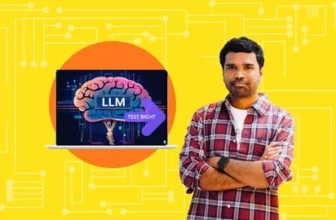
Master Apache Spark with over 9 hours of hands-on PySpark training and expert instruction by Frank Kane—use coupon SUNDOG1M to enroll now!
Table of Contents
Overview of Taming Big Data with Apache Spark 4 and Python – Hands On! Course on Udemy
Dive into the world of big data with the Taming Big Data with Apache Spark 4 and Python – Hands On! course on Udemy, designed to equip you with practical skills to analyze massive datasets using PySpark. Led by Frank Kane, a former Amazon and IMDb engineer, this course offers over 9 hours of on-demand video, 20+ downloadable resources, and a certificate of completion. You’ll learn to harness Apache Spark’s power to process gigabytes of data efficiently, both locally and in the cloud using Amazon’s Elastic MapReduce service. With lifetime access, mobile and TV compatibility, and real-world examples, this course is perfect for developers aiming to excel in data engineering. Enroll today with udemy coupon codes SUNDOG1M (valid until July 31, 2025—check the offer box below for the discount link!)
What to Expect from the Taming Big Data with Apache Spark 4 and Python – Hands On! Course
This course delivers a hands-on learning experience through over 9 hours of video content, focusing on Python and PySpark to tackle big data analytics. Frank Kane’s teaching style is practical and example-driven, guiding you through 20+ real-world tasks, from analyzing movie ratings to building social graph analyses. Aimed at developers with some programming experience, it’s ideal for those transitioning to data science or enhancing their data processing skills. The course is accessible on Udemy’s platform across mobile, TV, and desktop, allowing flexible learning at your own pace.
What You Will Learn in Taming Big Data with Apache Spark 4 and Python – Hands On!
- Master the concepts of Resilient Distributed Datasets (RDDs) and DataFrames in Apache Spark.
- Develop and run Spark jobs quickly using Python and PySpark.
- Translate complex analysis problems into iterative or multi-stage Spark scripts.
- Scale data processing using Amazon’s Elastic MapReduce service.
- Understand how Hadoop YARN distributes Spark across computing clusters.
- Explore advanced Spark technologies like Spark SQL, Spark Streaming, and GraphX.
Why Choose This Taming Big Data with Apache Spark 4 and Python – Hands On! Course on Udemy
This course stands out due to Frank Kane’s industry expertise, having worked at Amazon and IMDb, ensuring real-world relevance. The content is updated for Spark 4, covering the latest features like Structured Streaming. With 9 hours of video and 20+ downloadable resources, it offers immense value for aspiring data engineers. The hands-on approach, coupled with practical examples like movie recommendation systems, makes it a top choice for mastering big data. Use udemy promo codes SUNDOG1M to get at a discount (see offer box)
Recommended Courses with Big Data Focus
Looking to expand your skills? Check out these related courses:
Elasticsearch 9 and the Elastic Stack: In Depth and Hands On Best seller
- Apache Spark with Scala – Hands On with Big Data: Learn Spark using Scala for optimal performance with 20+ hands-on examples.
- Spark and Python for Big Data with PySpark: Master Spark 2.0 DataFrames, machine learning, and streaming with Python.
- Big Data with Apache Spark and AWS: Build high-performance Spark clusters on AWS for real-world data solutions.
- Apache Spark 3 for Data Engineering & Analytics with Python: Comprehensive PySpark training using Databricks on Google Cloud.
Our Review of Taming Big Data with Apache Spark 4 and Python – Hands On! Course
From a website admin perspective, this course is a well-structured, practical guide to mastering Apache Spark with Python. Frank Kane’s clear explanations and industry experience make complex concepts accessible, with 20+ hands-on examples ensuring learners can apply their skills immediately. The course is particularly valuable for its cloud-based exercises using Amazon EMR, though it assumes basic programming knowledge, which may challenge absolute beginners.
Pros:
- Engaging, hands-on projects like movie recommendations enhance learning.
- Comprehensive coverage of Spark technologies, including Spark Streaming.
- Lifetime access and mobile compatibility offer flexibility.
Cons:
- Requires prior programming experience, limiting accessibility for novices.
- Some advanced topics could benefit from deeper exploration.
With udemy courses coupon SUNDOG1M, it’s a steal
Rating the Taming Big Data with Apache Spark 4 and Python – Hands On! Course
- Content: 9.5/10 – Covers all essential Apache Spark topics, from RDDs to GraphX.
- Delivery: 9.5/10 – Clear and engaging, though pacing can feel fast for complex topics.
- Value: 9/10 – Affordable with udemy discounts coupon SUNDOG1M.
Enroll now to master big data analytics with this top-tier course
Additional Information from Search Insights
The course aligns with trending search keywords like Apache Spark, PySpark, big data, data engineering, Spark SQL, Hadoop YARN, Spark Streaming, Elastic MapReduce, data science, and Python. These terms reflect the growing demand for skills in processing large datasets, a critical need in industries like tech, finance, and e-commerce. By focusing on practical, real-world applications and leveraging Python’s accessibility, this course meets the needs of learners seeking to stay competitive in the big data analytics landscape.









